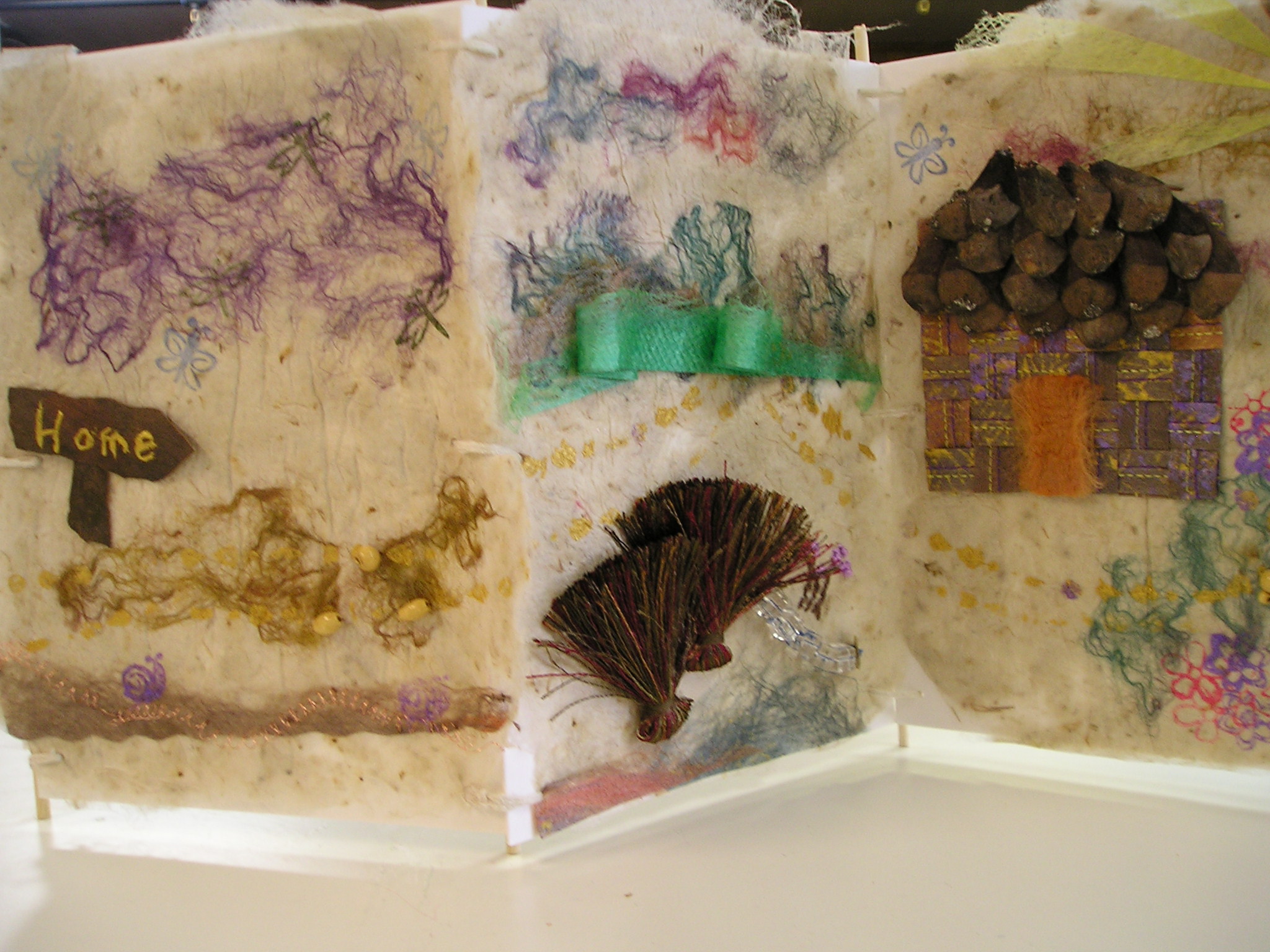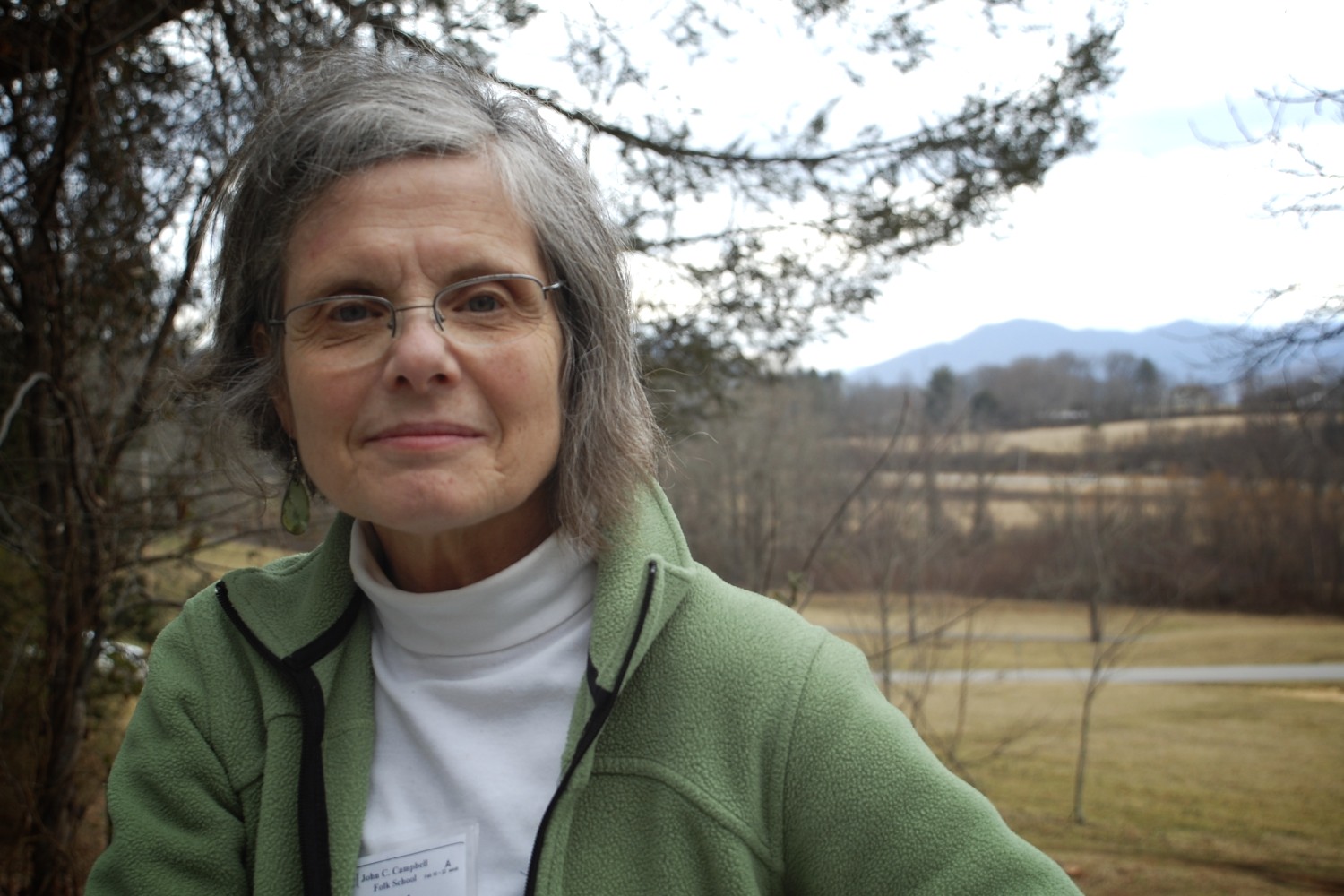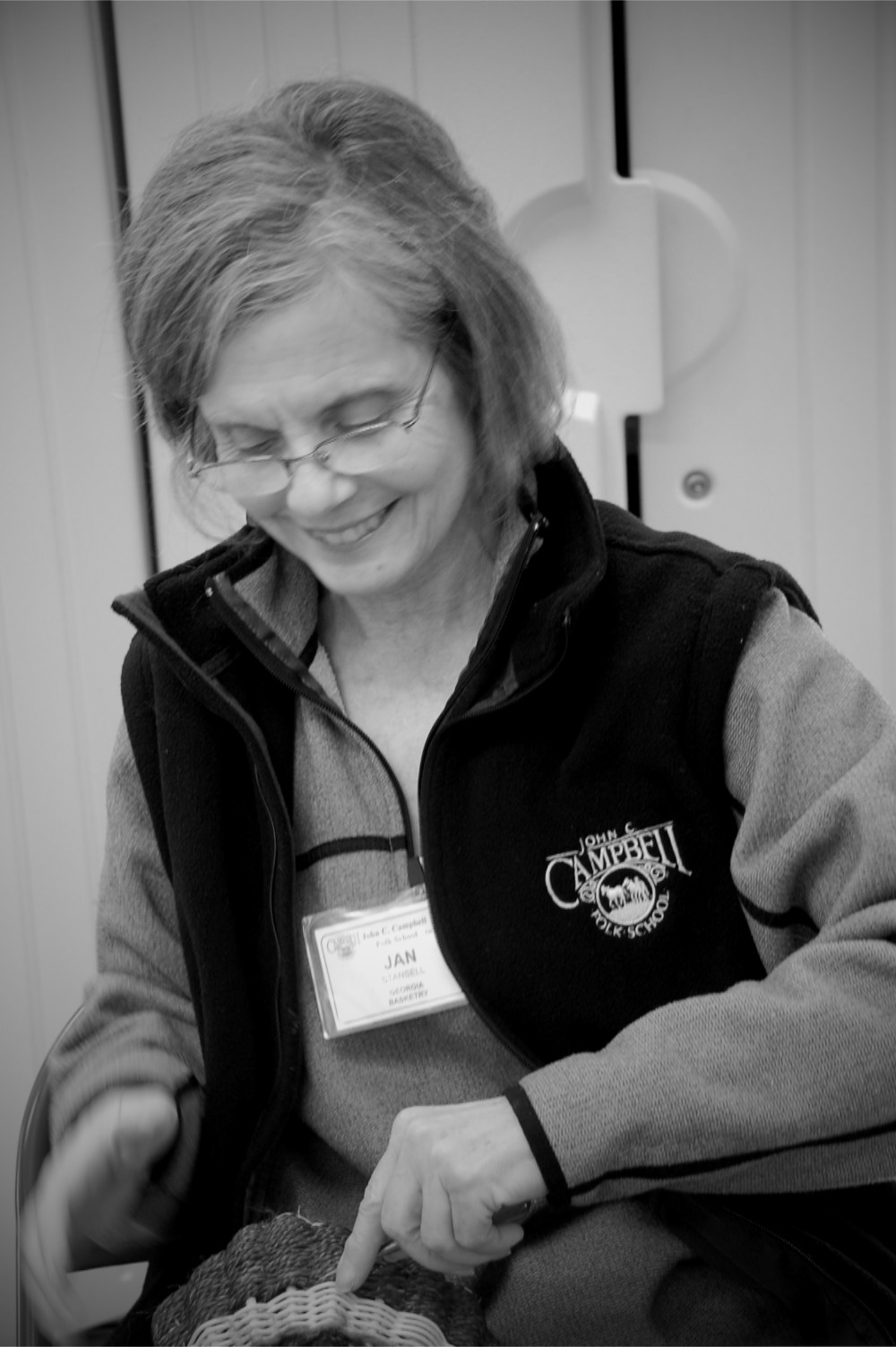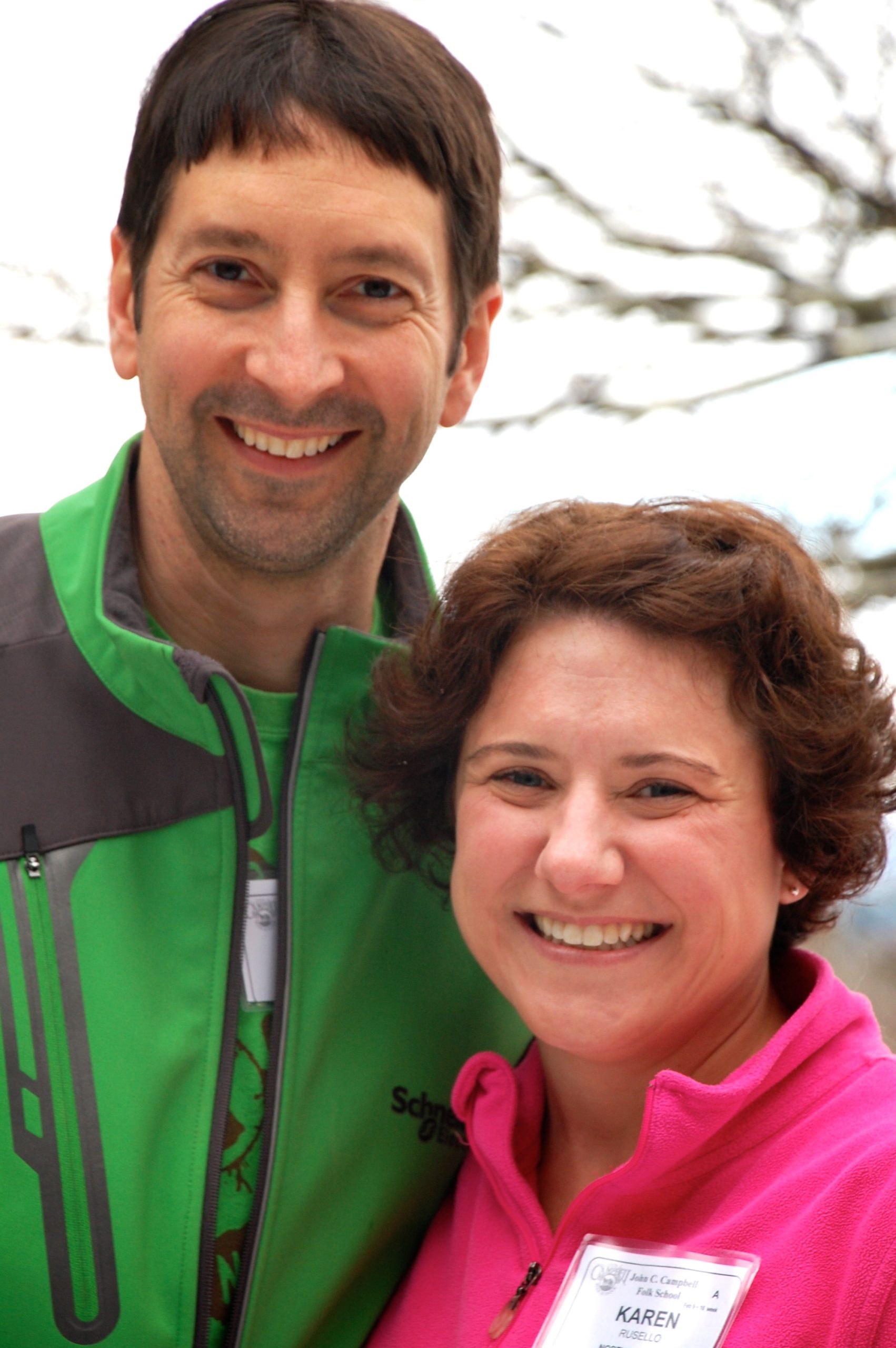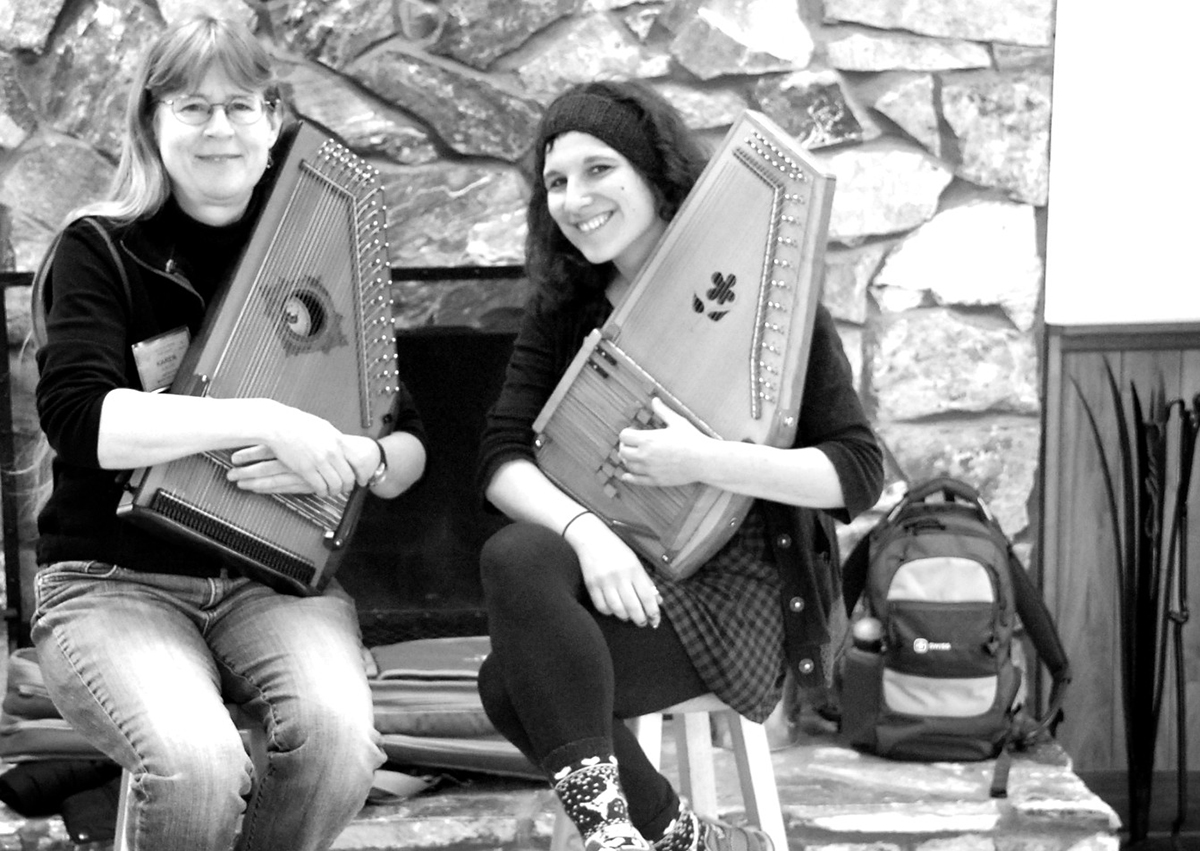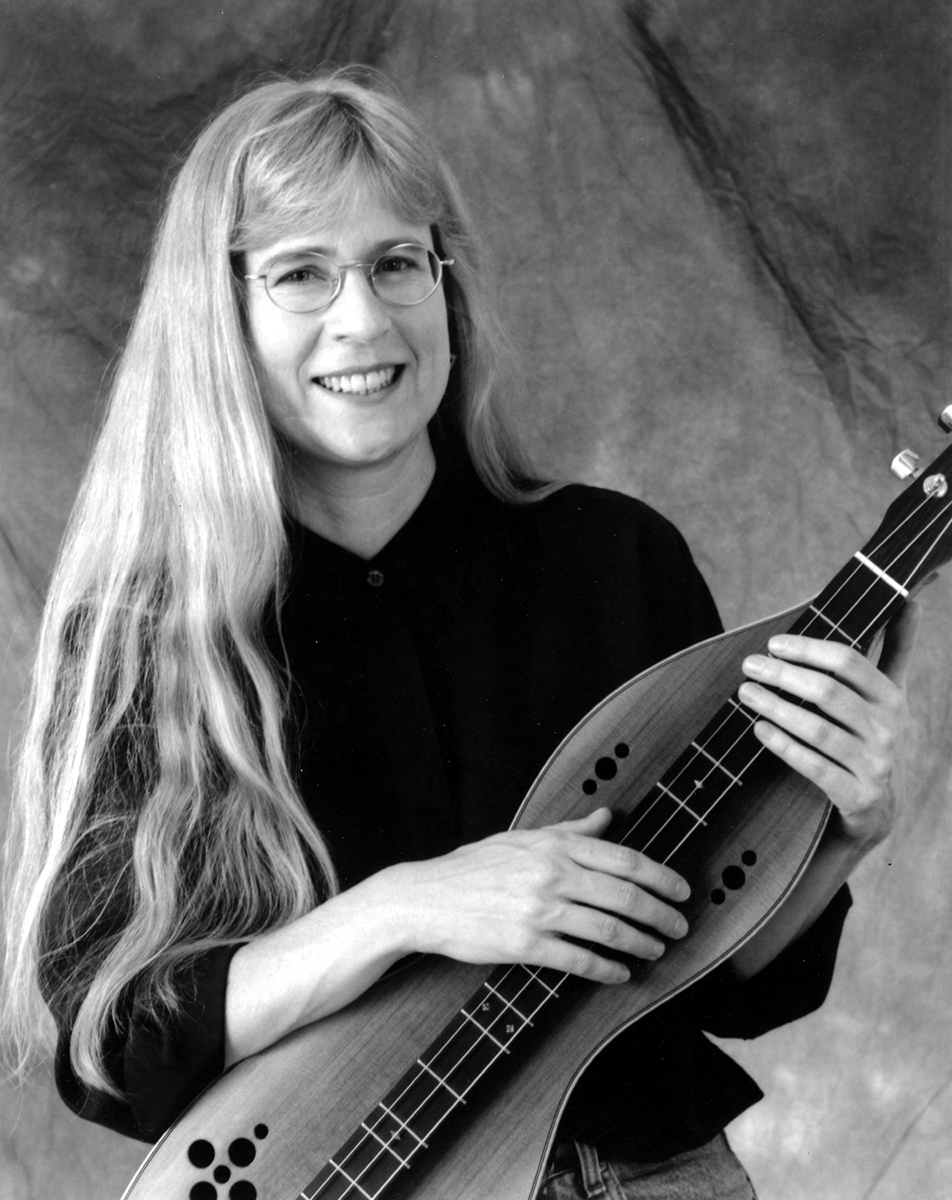It’s Valentine’s Day here at the Folk School. I caught up with some friends and classmates this week to hear more about what folks are doing to mark the occasion.
Karen and Paul
[caption id="attachment_9968" align="alignright" width="232"]
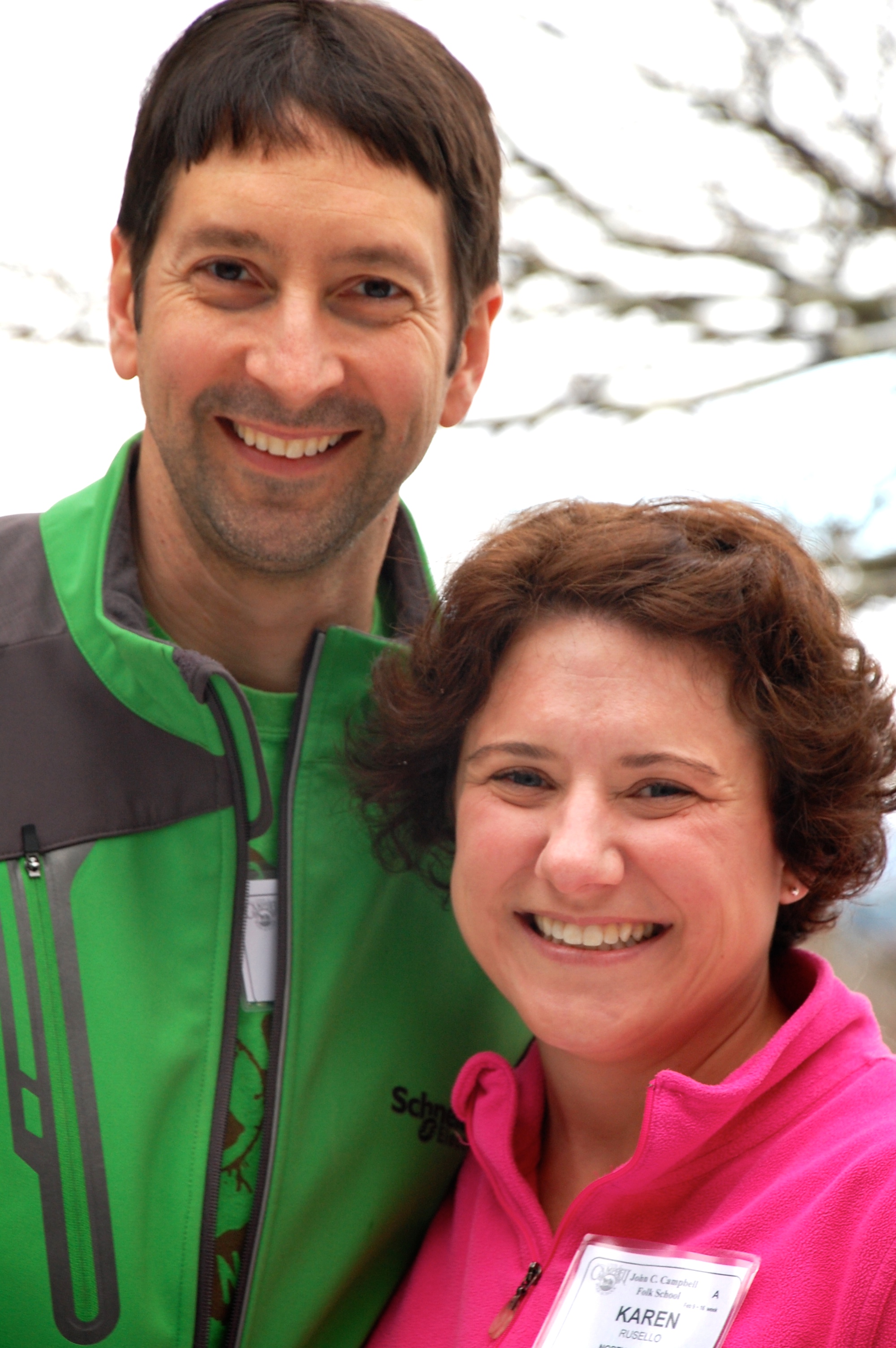
Wood turners and spinners make good sweethearts.[/caption]
Karen is a second-time Folk School student who brought her husband Paul here for the first time. They did not pick this week intentionally for Valentine’s Day but are happy to be here to celebrate with the Folk School community. Karen and I are classmates in Martha Owen’s Sheep to Shawl spinning/dyeing class together, while Paul is over in the Woodturning class with Phil Colson.
Karen: I loved it here and knew he would love it too. So we looked through the catalog and found a week where we could be here and work on stuff together.
Leah: So between the two of you, who is craftier?
Paul: She is.
Karen: I might be more artistic, but Paul’s an engineer. He is into figuring out how stuff works and making beautiful things that function well.
Leah: What are you learning this week that you will take home with you?
Paul: In wood turning, you have to concentrate hard for short amounts of time and then stand back and watch to see the potential emerge. I think that’s something I am taking away from this week that applies in our life.
Karen: (laughs) So you concentrate on me for short periods of time??
Paul: (laughs) Yes – and then all the potential emerges.
Karen: I think the way we are spending time with each other this week is really reflective of how we want our lives to be, so it’s a good way to practice what to prioritize.
Leah: That’s beautiful you guys. However, I actually meant – what are you literally taking home for each other?!
Paul: I am making some spinning tools, and a bunch of stuff for our home. And I am working on a special thing that I haven’t told her about yet.
Karen: I am learning a bunch of techniques. I don’t know how much knitting I am going to get done, but eventually these techniques will turn into sweaters. Or socks.
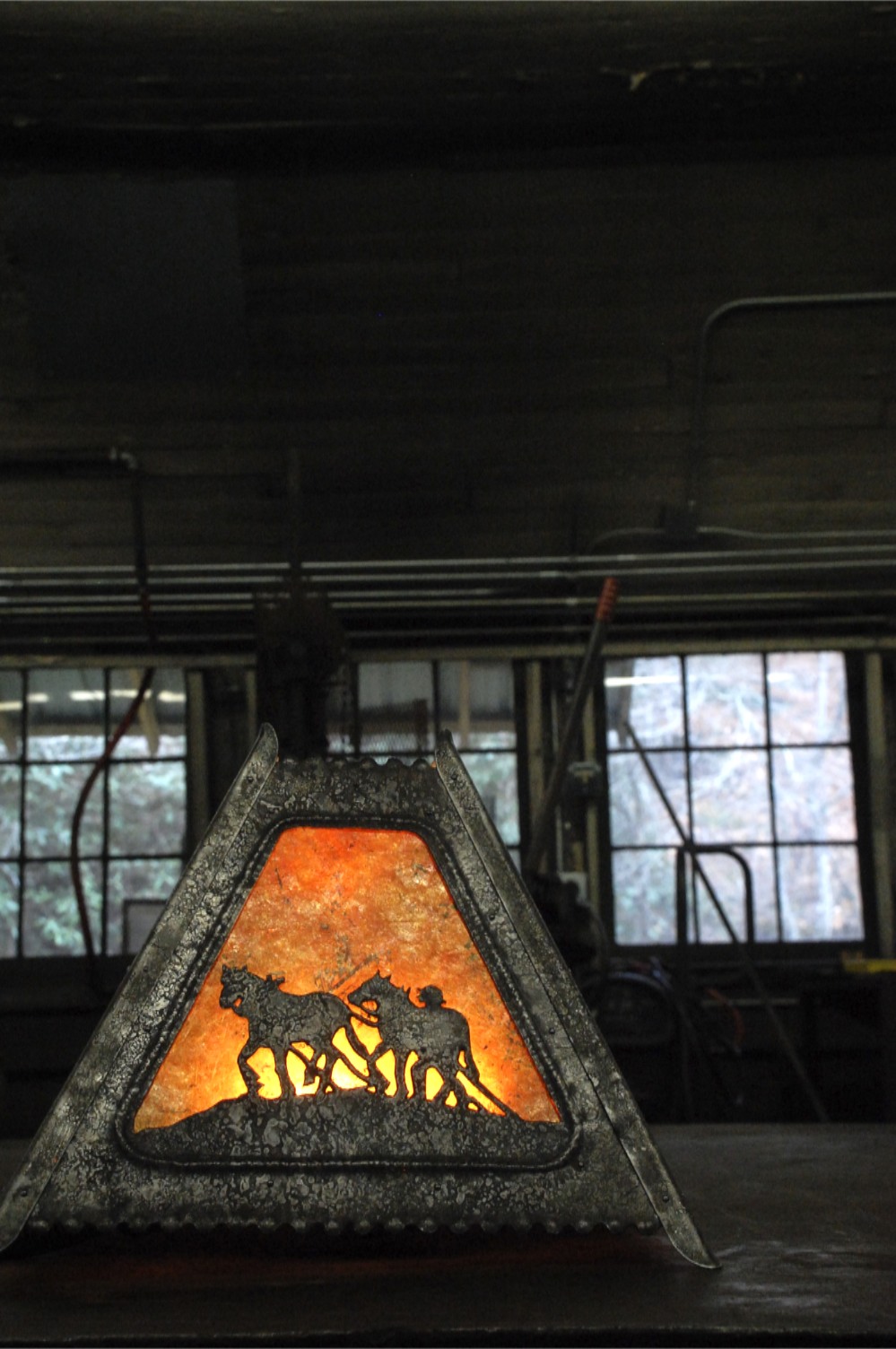 Sing Behind the Plow lampshade by Ron Nichols[/caption]
Blacksmith Work Week is an annual Folk School tradition, bringing 20 professional blacksmiths/instructors from around the country together to volunteer their time for the purposes of 1) beautifying the Folk School campus with functional ironwork; 2) repairing and creating new tools and infrastructure for the Blacksmithing program; and 3) spending a week learning and exchanging in the company of peers and mentors.Work Week was started by Clay Spencer (namesake of the new blacksmith shop) in the early 1990s and is currently coordinated by Paul Garrett, resident artist blacksmith. I had the chance to visit the shop and interview some of the blacksmiths as they put finishing touches on their projects and reflected on their connection to this very special community and yearly opportunity to participate in Work Week.
Leah Dolgoy: Paul, how’s it gone this week? What were your priority projects and what’s been accomplished during Work Week?
Paul Garrett: There were many priorities this year. One was making chandeliers for upstairs. They won’t get done this year but we’ll keep working on them next year. The shop is named after Clay Spencer so I gave Clay free reign on the design and he chose something very contemporary and out of the ordinary. Other priorities included work in some of the studios. We mounted some equipment for the Jewelry studio. We built a pot rack for the cooking studio. And we finished installing the door latches I made for the main door to the new blacksmith shop. We made two treadle hammers, and two treadle torches. We fixed a lot of tools – hammers and tongs, punches and grips. We also do whatever else pops up. I really wanted to do the Keith House door so that got done this year. We etched and epoxied the bathroom floor in the shop so that housekeeping can come in and clean it more easily now. Then there are all the little things that come up. I have these little job sheets that I put out and I find that works well. People pick their jobs based on their area of interest and expertise.
LD: What does it mean to be the coordinator of this thing that everyone regards as so special?
[caption id="attachment_10391" align="alignright" width="232"]
Sing Behind the Plow lampshade by Ron Nichols[/caption]
Blacksmith Work Week is an annual Folk School tradition, bringing 20 professional blacksmiths/instructors from around the country together to volunteer their time for the purposes of 1) beautifying the Folk School campus with functional ironwork; 2) repairing and creating new tools and infrastructure for the Blacksmithing program; and 3) spending a week learning and exchanging in the company of peers and mentors.Work Week was started by Clay Spencer (namesake of the new blacksmith shop) in the early 1990s and is currently coordinated by Paul Garrett, resident artist blacksmith. I had the chance to visit the shop and interview some of the blacksmiths as they put finishing touches on their projects and reflected on their connection to this very special community and yearly opportunity to participate in Work Week.
Leah Dolgoy: Paul, how’s it gone this week? What were your priority projects and what’s been accomplished during Work Week?
Paul Garrett: There were many priorities this year. One was making chandeliers for upstairs. They won’t get done this year but we’ll keep working on them next year. The shop is named after Clay Spencer so I gave Clay free reign on the design and he chose something very contemporary and out of the ordinary. Other priorities included work in some of the studios. We mounted some equipment for the Jewelry studio. We built a pot rack for the cooking studio. And we finished installing the door latches I made for the main door to the new blacksmith shop. We made two treadle hammers, and two treadle torches. We fixed a lot of tools – hammers and tongs, punches and grips. We also do whatever else pops up. I really wanted to do the Keith House door so that got done this year. We etched and epoxied the bathroom floor in the shop so that housekeeping can come in and clean it more easily now. Then there are all the little things that come up. I have these little job sheets that I put out and I find that works well. People pick their jobs based on their area of interest and expertise.
LD: What does it mean to be the coordinator of this thing that everyone regards as so special?
[caption id="attachment_10391" align="alignright" width="232"]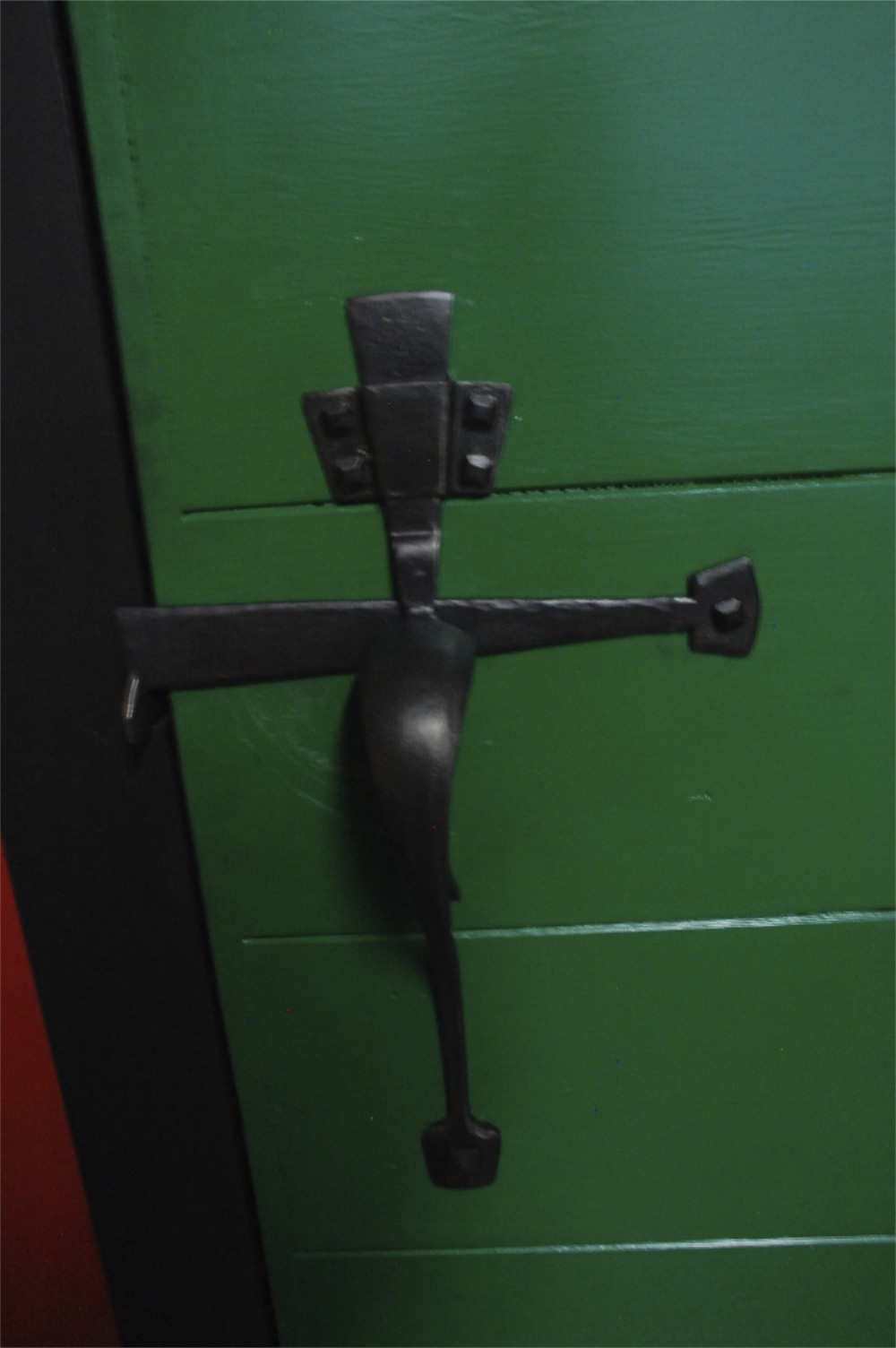 New door hardware for the Blacksmith Shop made by Paul Garrett[/caption]
PG: For me, it’s an honor and a privilege to be a part of Work Week. I just love having everyone here. As the coordinator, it’s up to me to make the most of it. We have 1000 hours of volunteer labor every year. My role is to keep everyone else working, and to make sure that they can get what they need to get the job done. Funny story - 13 or 14 years ago I came here as a student, and I asked Clay if I could come to Work Week. And basically he said no, because he had enough people and he didn’t really know me that well. (laughs) It wasn’t to be mean or anything. He just had his team that he needed. I understand that now that I am on the other side of it. I believe this is my 10th year as the Work Week coordinator.
New door hardware for the Blacksmith Shop made by Paul Garrett[/caption]
PG: For me, it’s an honor and a privilege to be a part of Work Week. I just love having everyone here. As the coordinator, it’s up to me to make the most of it. We have 1000 hours of volunteer labor every year. My role is to keep everyone else working, and to make sure that they can get what they need to get the job done. Funny story - 13 or 14 years ago I came here as a student, and I asked Clay if I could come to Work Week. And basically he said no, because he had enough people and he didn’t really know me that well. (laughs) It wasn’t to be mean or anything. He just had his team that he needed. I understand that now that I am on the other side of it. I believe this is my 10th year as the Work Week coordinator.




